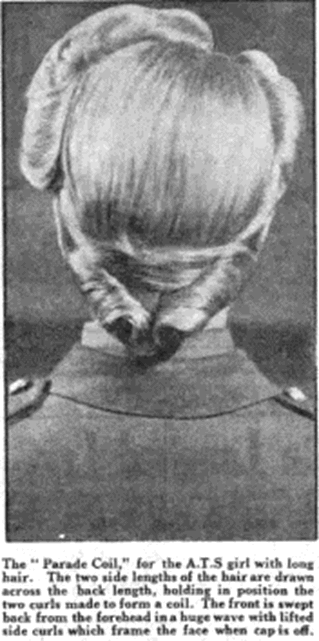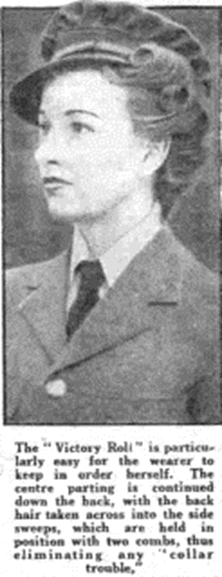Some Uniform Woes of the W.A.A.F.
In June 1940 the warm weather caused a change in Air Ministry Orders. For the for the first time there was a change in the hosiery of W.A.A.F.s. Air Ministry Order- A.364 (A.65340/40- 6.6.40) ordered that it was to be allowed that in warmer weather “W.A.A.F.s may wear lisle stockings of lighter weight than the present approved pattern. They must be of dark mole grey colour, 48 gauge, and those who choose to wear them must provide and maintain them at their own expense.”
The wearing of silk or transparent stockings remained taboo! In August 1940 there was a review within the services of the wearing of uniforms by women who were initially ordered to wear uniform constantly. When the war began, A.T.S. and W.A.A.F and W.R.E.N. girls were faced with different rulings of commanding officers as they moved from one station to another. Some officers had no time for such fripperies. Others allowed the women the luxury of clinging frocks and sheer stockings when they were off duty. The Navy was one branch that showed the greatest understanding of women who liked their own dainty dresses. In contrast the A.T.S. and the W.A.A.F insisted that women wear uniform on all occasions except when on leave for more than 24 hours.
The
W.R.E.N.S. had to wear uniform to and from duty, on duty, within a naval or
marine establishment, even when not on duty and all official and semi-official
occasions. At home or even on short leave they did not have to wear uniform and
were encouraged to do so. This policy reduced wear and tear
on the uniform. When doing any recreational activities Ratings and officers did
not have to wear uniform. For naval or marine dances, uniform had to be
worn unless special permission had been obtained to wear frocks. New regulations
were issued that would allow all women in uniform to slip into feminine
frills and fancies when they go on leave.
In
1941 fashion news it was stated that members of the Women's Auxiliary Air Force
were banned from using bright-coloured nail polish. Other taboos were
“The Page Boy Bob” and “The Ginger Rogers Roll,” because regulations
decree that hair must not touch the collar of the greatcoat. Although make-up—even
on parade—is permitted if used in moderation. At the same time, prosperity
smiled on one enterprising hairdresser member of the W.A.A.F.
who opened a beauty parlour in a spare hut. Her ingenuity in keeping within
regulations, while creating fetching hair styles, was much admired. She
was most popular just before the weekly dance, which was the highlight of the
social life of the station.
In
January 1941 the Conservative M.P for Stretford, Flight-Lieutenant Ralph
Etherton tabled a question in the House of Commons to ask the Secretary of State
for Air to confirm and give assurance that there was no intention of changing
the present gun-metal grey colour of stockings issued to the Women’s Auxiliary
Air Force. This question caused reporters to question Air Ministry officials
about this and were reassured that all the W.A.A.F.’s were very happy with
the colour and there had never been any intention of changing it. Quite what
caused the M.P. to raise this question was unclear.
In
1939 after war broke out the Board of Trade had banned the sale of silk
stockings unless they were being exported. This meant that thousands of pairs were
lying around in warehouses unsold. This was why the various “spivs” would
sell any they could find on the black market at high prices. The Board of Trade
was advised in early 1941 that silk stockings would deteriorate after two years
and reviewed their policy of banning the sale. A census was taken of stocks
held across the country and it was declared that some could be sold in the
shops, but the bulk would be exported abroad. However, many W.A.A.F.s
had kept pairs from before the ban and it was quite common to find that they
were storing them in airtight jars and bottles and kept under the stairs
to prevent light deteriorating them!
By
June 1941 the war had begun to impact the availability of cloth and rationing
had to be brought in.
Women
serving their country in the A.T.S., the W.A.A.F.s, or W.R.N.S., were very badly
hit, for they are to have no clothing ration books. Every Servicewoman
knows, however, that she requires extra stockings, underwear, handkerchiefs and
so on. The matter apparently is to be reconsidered.
Hats Caused Issues With W.A.A.F Hairstyles

The
hair problems of Service girls soon came to the attention of Britain's leading
hair designers in January 1941. The
difficulty of coping with Service regulations, while matching feminine charm
with the severe lines of military uniforms, had given many A.T.S., W.A.A.F.
and W.R.E.N. girls hours of after duty headaches. Robert Douglas, Ltd., the
leading West End hair stylists, of 71. South Audley Street, W.1, solved
some of these problems.
Here
were two answers to an A.T.S. and a W.A.A.F. cry for help. The A.T.S. girl who
does not wish to cut her hair while conforming to Service regulations,
which require that the hair shall not touch the collar, can adopt the Parade
Coil style shown on the left. The Victory Roll (shown right) is designed
to flatter the contour of the face without being too severe under a Service cap.


In
September 1941, make-up and cosmetics were in the news as they were in short
supply. The Board of Trade was the culprit. Supplies
of cosmetics had been cut down to shops and N.A.A.F.I. to 25 per cent. of
previous supplies. Despite the protests the Board of Trade had refused to
release larger stocks to N.A.A.F.I. for servicewomen.
Shortages
also impacted the call-up for W.A.A.F.s. They were being recruited at the rate
of 2,000 to 3,000 women a day. The Air Force did not have the accommodation,
beds, blankets, uniforms at training schools or Air Force stations. Even when
given a service number some women were waiting months to
be called up.
In
July 1942 with America now at war it was natural to compare the way the American
services equipped women compared to the British way. It was revealed
that the American equivalent of our W.R.N.S. were given a money grant and were
expected to provide their own underwear. A new A.T.S. or W.A.A.F.
is supplied with everything, but a girl joining the W.R.N.S. was given ten
shillings to buy underwear. Her American counterpart did rather better on
£5O, while the girl in the American equivalent of the A.T.S. received sixteen
pairs of stockings and general equipment, which included a bathing suit and
a pair of sunglasses!
In
August 1942 economists working for the Air Ministry had accumulated considerable
data on the life expectancy of uniforms worn by service personnel.
|
UNIT |
CLOTHING
ITEM |
LIFE
EXPECTANCY |
|
W.A.A.F. |
SHIRT
|
12
MONTHS |
|
|
JACKET
/TUNIC |
9
MONTHS |
|
|
STOCKINGS
|
6
WEEKS |
|
|
CORSETS |
9
MONTHS |
|
|
PYJAMAS
|
24
MONTHS |
|
|
SWEATERS |
24
MONTHS |
|
R.A.F. |
SHIRT |
9
MONTHS |
|
|
JACKET
/TUNIC |
12
MONTHS |
|
|
SOCKS |
4
MONTHS |
|
|
TROUSERS |
6
MONTHS |
|
|
BOOTS |
9
MONTHS |
|
|
GREATCOATS |
48
MONTHS |
In December 1942 it was reported that no changes had been found necessary in the smart uniform of the W.A.A.F. which was originally devised in colour and cut to show the close connection between the W.A.A.F. and its parent fighting service. The badges of rank and buttons are identical with those of the R.A.F. The items of kit issued to recruits included two uniforms, unless the airwoman's trade necessitates that she should wear a working serge suit for duty in which case she received one uniform and one working serge suit. Cap, greatcoat, cardigan, scarf, blue overalls for domestic work, six collars, three shirts, one pair of gloves, one tie, three pairs of stockings, two pairs of shoes and one pair of canvas shoes are all issued, in addition to underwear.
The underwear came in light and dark colours and was referred to as “twilights” or “blackouts”!
In December 1943 the Air Ministry decided on health and economy reasons, that W.A.A.F. airwomen were to be issued with a third pair of black shoes, so that they would always have at least one pair serviceable. Each pair of shoes was be expected to last longer than has been possible previously. This decision was also hastened by the shortage of cobblers in 1943.
In
November
1944 with D-day over and the war being fought in Europe there was indeed some
lightening up of the restrictions on clothing. Members
of the W.R.N.S. and A.T.S had been given permission to wear silk stockings when
off duty, but the Air Ministry had refused until the matter was raised
in Parliament. Captain Balfour, Under-Secretary for Air replied, amid
cheers, "Yes
,this concession will now be introduced.” The only condition was that they
had to be grey to match the uniform.
Peter Garwood 2021